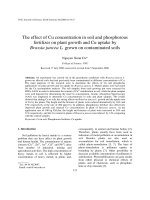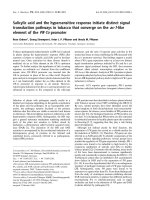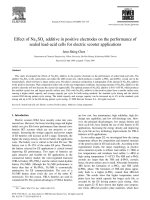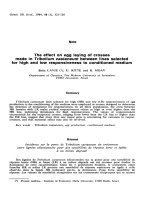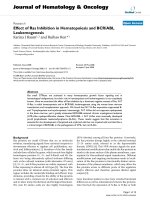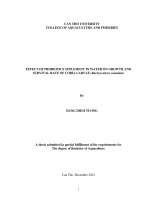Effect of salicylic acid and effective microorganism on growth and yield of mung bean in autumn winter 2020
Bạn đang xem bản rút gọn của tài liệu. Xem và tải ngay bản đầy đủ của tài liệu tại đây (5.84 MB, 90 trang )
VIETNAM NATIONAL UNIVERSITY OF AGRICULTURE
FACULTY OF AGRONOMY
UNDERGRADUATE THESIS
TITLE:
EFFECT OF SALICYLIC ACID AND EFFECTIVE
MICROORGANISM ON GROWTH AND YIELD OF
MUNG BEAN IN AUTUMN – WINTER 2020
Supervisor
:
PhD. PHAM TUAN ANH
Department
:
PLANT PHYSIOLOGY
Student
:
NGUYEN THI MY LINH
Class
:
K61 – KHCTT
Student code
:
611703
Ha Noi – 2021
DECLARATION
I declare that the thesis is the result of my own research. The data and
results mentioned in this thesis are honest and not used in any published thesis,
dissertations, and scientific research projects previously.
I hereby commit that the information cited in the thesis ensuring cited as
prescribed. I bear full responsibility for these reassurances.
Hanoi, February 2021
Student
Nguyen Thi My Linh
i
ACKNOWLEDGEMENTS
This thesis was made with the support and assistance of a number of
people whom I would like to personally thank.
First and foremost, I would like to express my gratitude to my supervisor
PhD. Pham Tuan Anh, who supervised me through my thesis, providing useful
advices for the improvement of this work.
Very special thanks go out to all the teachers in the Faculty of Agronomy,
especially the teachers in the Department of Plant Physiology create facilitate
conditions and have many valuable ideas to help me in the course of graduation
thesis.
The last but not least, I would like to express the gratitude to my family
and my colleagues for the support they provided me through my study. This
would not have been possible without their support and helping.
Hanoi, February 2021
Student
Nguyen Thi My Linh
ii
CONTENT
DECLARATION ................................................................................................... i
ACKNOWLEDGEMENTS .................................................................................. ii
CONTENT ........................................................................................................... iii
LIST OF ABBREVIATIONS ............................................................................... v
LIST OF TABLES .............................................................................................. vii
LIST OF FIGURES ............................................................................................ viii
SUMMARY ....................................................................................................... viii
PART I GENERAL INTRODUCTION ............................................................... 1
1.1. Background .................................................................................................... 1
1.2. Objectives and requirements .......................................................................... 2
1.2.1. Objectives .................................................................................................... 2
1.2.2. Requirements ............................................................................................... 3
PART II LITERATURE REVIEW....................................................................... 4
2.1. Overview of mung bean ................................................................................. 4
2.1.1. Orign............................................................................................................ 4
2.1.2. Charateristic ................................................................................................ 5
2.1.3. The roles ...................................................................................................... 6
2.2. Ecological requirements of mung bean .......................................................... 7
2.3. Situation of mung bean research in the world and Vietnam .......................... 9
2.3.1. Situation of mung bean research in the world............................................. 9
2.3.2. Situation of mung bean research in Vietnam ............................................ 11
2.4. Research about Effective Microorganisms (EM) and Salicylic acid (SA) .. 13
2.4.1. Research about Effective Microorganisms (EM) ..................................... 13
2.4.2. Research about Salicylic acid (SA) ........................................................... 17
PART III MATERIALS AND METHODS........................................................ 21
3.1. Materials ....................................................................................................... 21
iii
3.2. Experiment site and research time ............................................................... 21
3.3. Research Contents ........................................................................................ 22
3.4. Methods ........................................................................................................ 22
3.4.1. Experimental design ................................................................................ 22
3.4.2. Cultural practices .................................................................................... 22
3.4.3. Data collection ........................................................................................ 23
3.5. Managing collected data .............................................................................. 26
PART IV RESULTS AND DISCUSSION ......................................................... 27
4.1. Effect of EM and SA on the stem height. .................................................... 27
4.2. The effect of EM and SA on the number of leaves...................................... 30
4.3. Effect of EM and SA on number of 1st grade branches .............................. 32
4.4. Effect of EM and Acid SA on Leaf area and Leaf area index (LAI) ........... 35
4.4.1. Effect of EM and Acid SA on Leaf area ................................................... 35
4.4.2. Effect of EM and Acid SA on Leaf area index (LAI)............................... 36
4.5. Effect of EM and SA to SPAD .................................................................... 37
4.6. Effect of EM and SA on nodule formation .................................................. 39
4.7. Effect of EM and SA on cumulative dry matter ....................................... 42
4.8. Effect of EM and SA on photosynthetic performance ................................. 43
4.9. Effect of EM and SA on the yield and yield components............................ 45
4.9.1. Effect of EM and SA on the yield components ........................................ 45
4.9.2. Effect of EM and Acid SA on the yield .................................................... 47
PART V CONCLUTIONS AND RECOMENDATIONS ................................. 51
5.1 Conclusions ................................................................................................... 51
5.2 Recomendations ............................................................................................ 52
REFERENCES .................................................................................................... 53
ANALYZING DATA IRISTART ...................................................................... 57
APPENDIX ......................................................................................................... 74
iv
v
LIST OF ABBREVIATIONS
Acronyms
English meaning
CV%
Coefficient of variation
DAS
Day after sowing
EM
Effective Microorganisms
Et al
And others
FH
Final height
IRRISTAT
Agricultural statistical software
LAI
Leaf area index
LSD
Least significant different
No.
Number
SA
Salicylic acid
T
Treatment
W
Weight
vi
LIST OF TABLES
Table 2.1: Area, production and yield of mung beans 2014-2018 ..................... 10
Table 2.2. Mung bean production situation in some countries in the world in
2017-2018 ............................................................................................... 10
Table 2.3. Area and yield of mung bean in Vietnam .......................................... 12
Table 4.1. The effect of EM and SA on the stem height. ................................... 28
Table 4.2. Effect of EM and SA on the number of leaves .................................. 31
Table 4.3. Effect of EM and SA on number of 1st grade branches .................... 33
Table 4.4.. Effect of EM and SA on Leaf area index (LAI) ............................... 36
Table 4. 5 Effect of EM and SA on SPAD index ............................................... 38
Table 4.6. Effect of EM and SA to nodule formation ......................................... 40
Table 4.7. Effect of EM and SA on cumulative dry matter ............................. 42
Table 4.8. Effect of EM and SA on photosynthetic performance ....................... 44
Table 4.9.1. Effect of EM and SA on the yield components .............................. 45
Table 4.9.2. Effect of EM and SA on the yield................................................... 47
vii
LIST OF FIGURES
Figure 4.1. Growing dynamic of main stem height of mung bean ..................... 29
Figure 4.2. Growing dynamic of leaf number of mung bean ............................. 32
Figure 4.3. Growing dynamic of number of 1st grade branches ........................ 34
Figure 4.4. Effect of EM and SA on the yield .................................................... 49
viii
SUMMARY
Objectives
Research on the effects of Salicylic Acid and effective
microorganisms on the growth, development and yield of mung bean in the
autumn-winter 2020. From there, contribute to building an intensive farming
process to increase mung bean yield in Vietnam.
Research Methods
Effect of Salicylic and effective microorganisms on growth,
development and yield of mung bean in autumn-winter 2020 were arranged in
complete randomized blocks (RCBD- Randomized Coplete Bock Design) with 6
formulas, each with 3 replicates, each of the above formulas was sown. 1 plot,
the total number of experimental plots is 18 plots, the area of each plot is 6m2.
RCBD - Randomized Coplete Bock Design with one factor is comparison
between
the
unprocessed
Salicylic Acid
formula
and
the
effective
microorganism with the Salicylic treatment formula and the effective
microorganism.
Results and conclusions
Through the process of implementing and researching the topic:
"Effects of Salicylic Acid and efefective microorganisms on growth and
yield of DVXN7 mung bean in autumn-winter 2020’’, i draw some conclusions
as follows:
1. Treatment of EM and SA affected the growth indicators of DXVN7
mung bean. In which, T6 formula (using EM2 and 0.75mM SA) had the highest
height, the highest number of leaves, the total nodules and the highest nodule
weight at immature fruits period. T4 formula (using EM2) gave the highest 1 st
grade branches. T5 formula (using EM1 and 0.75mM SA) had the total nodules
and the highest nodule weight at flowering period.
ix
2. Treatment of EM and SA had different effects on the physiological
indicators of DXVN7 mung bean. T5 formulas for highest leaf area . The
formulas T4 (using EM2) formulas gave highest leaf area index. T3 formulas
highest photosynthetic efficiency. T6 formulas for highest dry matter and SPAD
index highest.
3. Treatment of EM and SA had different effects on the yield and yield
components of DXVN7 mung bean. The T4 formula (using EM2) gave the
highest number of seeds/fruits. The T6 formula (using EM2 and 0.75mM SA)
gave highest weight of 1000 seeds, highest fruits/plant, highest individual yield
and the highest actual yield.
x
PART I
GENERAL INTRODUCTION
1.1. Background
Mung bean (Vigna radiate (L.) Wilczek) belongs to the legume family,
grown for a long time and originated from India and Central Asia, distributed in
the tropics and tropical Asia .
Mung beans have a wide adaptability, quite drought tolerance and can
adapt to areas with extreme conditions.
Mung beans are short-term industrial crops with high nutritional value,
easy to grow and high economic efficiency for humans. Nutrients source from
seeds is rich in protein (23.4%), carbohydrates 53.1%), phosphorus, potassium,
magnesium and vitamins B1, B2, PP, C ... (Institute of Nutrition, 2007) and
acids Essential amines are irreplaceable for humans. The legume group makes
an important contribution to the soil ecosystem by the nitrogen-fixing symbiotic
bacteria in the roots. From mung beans can be processed into many different
delicious foods such as mung bean cake, mung bean milk ...; works in medicine
to cure a number of diseases for humans and as food for animals. In addition,
mung beans have a sweet, mild taste, welding properties, tonic gas, heat, cool
the liver, detoxify ... for humans . Mung bean has a short reproductive time and
is one of the three bean plants with many advantages in the production system,
so it is possible to participate in crop formulas (rotation, intercropping) to
contribute to enhancing the value of land use. A plant capable of improving soil
fertility by fixing free nitrogen through the action of symbiotic bacteria with
roots forming nodules after each crop of mung beans added to the soil 60 - 80 kg
N/ha. So after the soil is planted, mung beans will be more spongy, reducing
costs for inorganic nitrogen fertilizers, contributing to soil protection and
sustainable environmental protection.
1
With the advantage of being short-term plants, easy to grow, providing
many nutrients, improving soil and also very convenient to arrange in the
formula of rotation and intercropping, so green beans are grown quite popularly.
However, mung bean plants are only considered as sub-crops, so the planting
area is not concentrated and productivity is not high.
Salicylic acid (SA) is a plant hormone plays an important role in induction
of plant defense against a variety of biotic and abiotic stresses through
morphological, physiological and biochemical mechanisms. SA regulates
processes such as seed germination, vegetative growth, photosynthesis,
respiration, thermogenesis, flower formation, seed production, senescence, and a
type of cell death that is not associated with the hypersensitive response (Hayat
et al., 2010; Singh et al., 2017).
Effective Microorganisms (EM) act and interact in the soil-plant
environment to suppress plant pathogens and disease, to conserve energy, to
solubilise soil minerals, to aid the balance and ecology of soil microbes, and to
improve photosynthetic efficiency and biological nitrogen fixation. EM can
improve the quality and yield of plants by reducing the incidence of pests and
diseases, and by protecting against weeds, thereby contributing to sustainable
agriculture.
Following the fact mentioned above, we do a research on: “Effect of
salicylic acid and effective microorganism on growth and yield of DXVN7
mung bean in Autumn-Winter 2020”.
1.2. Objectives and requirements
1.2.1. Objectives
Evaluate the growth, development and yield of mung bean when treated
by salicylic acid and effective microorganisms in Autumn-Winter 2020.
2
1.2.2. Requirements
Evaluate the effects of Salicylic acid and effective microorganisms on the
growth and physiological parameters of mung beans.
Evaluate the effect of Salicylic acid and effective microorganisms on the
yield of mung bean.
3
PART II
LITERATURE REVIEW
2.1. Overview of mung bean
2.1.1. Orign
The mung bean (Vigna radiate (L.) Wilczek) is the third most important
bean plant after soybeans and peanuts (2 types of short-term industrial crops),
native to India and Central Asia, and from there spread to many other parts of
Asia.
Radiocarbon archaeological evidence has uncovered traces of mung
bean planted in many regions of India including the eastern part of the ancient
Harappan civilization area in Punjab and Haryana dating back about 4500 years,
and in The southern Indian state of Karnataka is more than 4000 years old.
Archaeological evidence also concluded that the green bean plant was widely
planted in India about 3,500-3,000 years ago (Ho Dinh Hai, 2014).
Currently, scientists have found the ancestor of the mung bean plant, the
subspecies Vigna radiata var, sublobata), which grows wild in Mongolia. That
said, Mongolia is also the place where the mung bean plant has been
domesticated for a long time.
In Thailand, traces of the planted mung beans and identified about 2200
years ago in the Khao Sam Kaeo area in southern Thailand.
In Africa, on the island of Pemba during the era of Swahili trade, in the
9th or 10th century, traces of planted mung bean plants have also been found.
Mung beans have a wide adaptability, quite drought tolerance and can
adapt to areas with extreme conditions. In Asia, mung beans are grown in many
countries such as India, Pakistan, Bangladesh, Sri Lanka, Nepal, China,
Myanmar, Thailand, Vietnam, Cambodia, Laos, ... Planted in Central Africa, the
dry and hot regions of Southern Europe, Northeastern Australia, South America
4
and the Southern United States.
In Vietnam mung beans are grown throughout the country from north to
south. This is an important vegetable and food species and a bean of special
value in Vietnamese culinary culture.
2.1.2. Charateristic
The mung bean (Vigna radiata (L.) Wilczek) is a legume cultivated for its
edible seeds and sprouts across Asia. There are 3 subgroups of Vigna radiata:
one is cultivated (Vigna radiata subsp. radiata), and two are wild (Vigna radiata
subsp. sublobata and Vigna radiata subsp. glabra). The mung bean plant is an
annual, erect or semi-erect (FAO, 2012; Lambrides et al., 2006; Mogotsi, 2006).
It is slightly hairy with a well-developed root system. Wild types tend to be
prostrate while cultivated types are more erect (Lambrides et al., 2006).
- Stems: stem much branched, with a tendency to twine at the tips,
angular, covered with long spreading hairs, reaching a height of 0.15-1.25 m and
it depends on the breed and cultivation (Mogotsi, 2006).
- Roots: root system consisting of a welldeveloped taproot with
deeply placed lateral roots. Airy loose soil the roots can grow up to 40 cm
deep, thereby the plant can drought tolerant better. Mung beans root can drought
tolerant good but waterlogging is very poor, especially small trees (0 -25 days
after sowing). From 15 days after sowing, the nodules are formed that are a very
effective to the plant.
- Leaves: Leaves alternate, dark green, trifoliolate with elliptical to ovate
leaflets 5-18 cm long x 3-15 cm broad, base broadly cuneate or rounded, apex
acuminate, glabrous or hairy on both surfaces, distinctly 3-veined from the base,
the lateral leaflets unequal-sided.
- Flowers: The pale yellow flowers are borne in clusters of 12–15 near the
top of the plant. Self-pollination occurs, so insects and winds are not required.
5
- Fruit: mung bean fruit is straight cylindrical, hairy. From bloom, the
fruit begins to grow and matures after 18-20 days. The fruit is green, more hairy,
when the old is dark green and when ripe is black and less hairy. Each fruit has
about 5-15 seeds.
- Seeds: The seeds are variable in colour, they are usually green, but can
also be yellow, olive or brown, the purplish brown or black, mottled and/or
ridged. Seed colours and presence or absence of a rough layer are used to
distinguish different types of mung bean. The weight per 1000 seeds is 30 - 70g.
2.1.3. The roles
Legumes (Fabaceae/Leguminosae) are considered the second most
important human food crops, just after the cereals (Gramineae). However,
legume seeds constitute an essential part of the human diet as they are excellent
sources of proteins, bioactive compounds, minerals, and vitamins, in comparison
with cereals, and are referred to as “the poor man’s meat” (Hall C et al., 2017).
The mung bean (Vigna radiata L.) is one of the most important edible
legume crops, is consumed all over the world, especially in Asian countries, and
has a long history of usage as traditional medicine. It has been known to be an
excellent source of protein, dietary fiber, minerals, vitamins, and significant
amounts of bioactive compounds, including polyphenols, polysaccharides, and
peptides, therefore, becoming a popular functional food in promoting good
health. For those individuals who cannot afford animal proteins or those who are
vegetarian, the mung bean is of a comparatively low-cost and has a good source
of protein for them. Furthermore, mung bean protein is easily digestible, as
compared to protein in other legumes (Yi-shen Z, Shuai S, 2018).
In addition to the nutritional properties of the mung bean, the
Compendium of Materia Medica (the “Bencao Gangmu”), a well-known
Chinese pharmacopoeia, has recorded that it can be utilized as traditional
medicine for its detoxification activities, recuperation of mentality, ability to
alleviate heat stroke, and regulation of a gastrointestinal upset. Interestingly,
6
apart from the ancient description, recent studies have identified many other
potential health benefits of the mung bean, such as its hypoglycemic and
hypolipidemic effects and its antihypertensive, anticancer, anti-melanogenesis,
hepatoprotective, and immunomodulatory properties beyond meeting basic
nutrient requirements (Liyanage et al., 2018).
Mung bean is one of the important crops with the ability to improve soil
fertility through N fixation by symbiotic association with rhizobia present in
root nodules. Therefore, the land after planting mung bean will become soft and
more nutritious, increase the productivity of the later crop (Jat et al., 2012). Dry
land areas are experiencing low agricultural yields due to severe water shortages
and salinity, leading to food scarcity. Mungbean is gaining attention as a shortseason crop that can tolerate dryland conditions and suitable with many type of
land. The economic benefits of mung beans when rotated with some other crops
such as groundnut have also been demonstrated (Arif and Malik, 2009).
2.2. Ecological requirements of mung bean
- Temperature:
Mung bean is a warm season crop requiring 90–120 days of frost-free
conditions from planting to maturity (depending on the variety). The optimum
temperature range for growth is between 27 °C and 30 °C (Duong Hong Dat,
2006). This means that the crop is usually grown during summer. Seed can be
planted when the minimum temperature is above 15 °C. Mung bean is
responsive
to daylight length. Short days result in early flowering, while long days
result in late flowering. However, mung bean varieties differ in their
photoperiod response. Mung bean is considered to be heat and drought tolerant.
-The light:
Mung bean is short-day plant and most are sensitive to conditions, time of
day light smaller 12 hours. The first sign of this reaction is that if the lighting
time is too long will cause prolonged period of growth and flowering slows. The
7
large day length influences the period of growth, it causes the flowering time to
prolong and slows the ripening of the fruit, so on the same tree at the same time
there are buds, flowers and green fruits, ripe fruit.
For light intensity, mung bean is bright loving plant, number of sunshine
hours must to reach 180-200 hours/month. During the flowering period, the
number of sunshine hours must to reach > 200 hours/month. So hours of
sunlight falls below 150 hours /month lead to plants will be weak, increases fall
flower rate, insect variety. So when arrangement to plant mung beans in systems
intercropping with other crops should allocate time to do so when the mung
beans have flower, fruit and body and leaves thrive, they will not be blocked the
light from to the main tree's leaves. The actual production was found to
productivity of mung beans are usually higher than spring season & -winterautumn season, at the southern provinces is higher than the north (Tran Dinh
Long, Le Kha Tuong, 1998; Duong Hong Dat, 2006).
-Humidity and rainfall:
Mung bean has good drought tolerance and poor water resistance. The soil
humidity is suitable for mung bean growth about 70-80%. Humidity and raining
have a great influence during the period of flowering and making fruit.
Adequate rainfall is required from flowering to late pod fill in order to ensure
good yield. Late plantings which result in flowering during the high
temperature-low moisture period in July and August will reduce yield. High
humidity and excess rainfall late in the season can result in disease problems and
harvesting losses due to delayed maturity.The required amount of raining for the
mung bean crop is 400-600 mm.
Mung bean seeds are small, so seeds are sensitive to soil humidity during
the budding period. The appropriate humidity is 70-80% and the humidity
uniformity determines the time, germination rate and uniformity of mung bean
fields during the growing period. The period when small plant has drought
8
tolerance that is considered the best. Relative drought in this period makes
condition for deep development root, increasing drought tolerance resistant for
later growth stages. During growth period, plants are sensitive to humidity. The
lack of humidity in this period increases the falling flower rate and drop fruit
-Soil and nutrition:
Mung beans is best suitable on fertile, sandy loam soils with good internal
drainage and a pH in the range of 6.3 and 7.2. Mung bean requires slightly acid
soil for best growth. If it is grown in rotation, lime to attain pH of the most acid
sensitive crop. Root growth can be restricted on heavy clays. Mung bean doesn’t
tolerate saline soils and can show severe iron chlorosis symptoms and certain
micronutrient deficiencies on more alkaline soils. PH <5 will reduce the
formation of effective nodules (Tran Dinh Long, Le Kha Tuong, 1998; Duong
Hong Dat, 2006).
Mungbean has phosphorus, potassium, calcium, magnesium and sulfur
requirements similar to other legumes which must be met by fertilizer additions
if the soil is deficient in these elements. Despite being legumes, mung bean still
need to be added with a certain amount of protein, especially for bad areas,
because of the protein due to bacterial of nodules level is not sufficient enough
for the plant, and in the early stages when the plant has not formed nodules yet.
2.3. Situation of mung bean research in the world and Vietnam
2.3.1. Situation of mung bean research in the world
Due to the increasing demand for human nutrition, protein rich products
such as mung beans are very interested and expected. Therefore, the area planted
to mung beans around the world has been expanded and increased significantly.
As shown in Table 2.1 below, it is estimated that the green bean area from 2014
to 2016 increased to about 67,000 ha.
9
Table 2.1: Area, production and yield of mung beans 2014-2018
Year
Area (million ha)
Production (tons/ha)
Yield (million tons)
2014
1,50
14,45
21,7
2015
1,54
15,05
23,18
2016
1,563
15,09
23,59
2017
1,568
15,43
24,21
2018
1,567
15,79
24,75
(Source: FAOSTAT,2019)
Mung bean yield also increased significantly, from 2014 to 2018
increased by about 1.3 tons / ha, the highest was in 2018 with 15.79 tons / ha.
Because the annual area increased, the production also increased, specifically, in
2014, it was only 21.7 million tons, but in 2018, it increased to 24.75 million
tons; an increase of more than 3.05 million tons compared to the previous years.
Based on the area and yield of mung beans increased over the years,
scientists have researched to create new resilient, high-yielding varieties to apply to
different regions of the world. Some regions have applied scientific and technical
advances to cultivating and ttested varieties and yielded quite high, below is table
2.2 showing acreage, production and yield in some countries in the world:
Table 2.2. Mung bean production situation in some countries in the world
in 2017-2018
Area (million ha)
Production (tons / ha)
Yield (million tons)
National
2017
2018
2017
2018
2017
2018
China
0,67
0,68
28,7
29,2
19,3
19,9
India
0,24
0,25
2,82
2,83
0,06
0,07
Indonesia
0,123
0,122
7,53
7,65
0,093
0,094
Thailand
0,16
0,16
1,86
1,87
0,03
0,03
America
0,09
0,09
3,1
3,2
0,003
0,003
(Source: FAOSTAT,2019)
10
As of 2018, China is a country with a large mung bean cultivation area
and productivity and yield are quite high, from 2017 to 2018 area increased by
0.01 million hectares but the yield increased to 0.5 tons / year. We can be seen
that China has applied very well scientific and technical advances and is
interested in breeding research to improve productivity on a large scale. Other
countries such as India, Thailand and the US all have small production areas,
leading to low productivity and yield, and many differences compared to China.
So recently, many countries around us such as India, Thailand, the
Philippines, etc. have paid attention to creating green bean varieties with yields
of 10-12 quintals / ha or more, large seeds, color The seeds are beautiful, have a
short growth time, are ripe relatively concentrated, and have quite resistance to
major pests and diseases.
2.3.2. Situation of mung bean research in Vietnam
In Vietnam, mung bean has been grown for a long time, throughout the
country, one of the traditional crops with many purposes: getting seeds, improving
soil, preventing erosion, making green manure ... But now, cultivated area is
limited, scattered from South to North, from delta provinces to midland and
mountainous areas. Mungbeans are not considered as the main crops, only
intercropping, crop planting, to take advantage of land, increase income, so the area
and productivity of mung beans in Vietnam is not high.
The area of mung bean production in Vietnam for 4 years of 2012 and 2015
varied from 88.180 – 98.200 ha, the area of mung bean production in 2015
decreased compared to 2012 was 7250 ha. The average mungbean productivity of
Vietnam over 4 years varies from 1026 - 1098 kg/ha. The average mung bean
productivity of the whole country tended to increase gradually over the years and
the highest yield in 2015 was 1098 kg/ha.
Mung bean production area in Vietnam is developed in 7 ecological regions
across the country (Table 2.3). The area of mung bean production between regions
11
in 2015 varied from 4880 - 25120 ha, of which 3 regions with large mung bean
production areas are the Central Highlands, North Central and South Central Coast
respectively: 25120 ha; 18470 ha; 18090 ha.
Table 2.3. Area and yield of mung bean in Vietnam
Area (1000ha)
yield (kg/ha)
Region
2012
2013
2014
2015
2012
2013
2014
2015
4.10
4.80
4.51
4.88
1463
1458
1452
1511
9.5
8.3
7.62
7.03
1095
1060
1004
1016
20.70 20.50
18.65
18.47
865
815
965
938
19.00 18.80
17.55
18.09
1132
1160
1172
1169
27.00 26.20
24.57
25.12
837
847
861
861
South East
9.60
8.60
8.00
9.61
1083
1081
1190
1237
Mekong Delta
8.30
6.60
7.28
7.76
1506
1576
1591
1719
Country
98.20 93.80
88.18
90.95
7981
7997
8235
8451
Red river delta
Northern
Midlands and
Mountains
North Central
South Central
Coast
Central
Highlands
(Source: National Institute of Agricultural Planning and Projection, 2016)
The average mung bean yield in the ecological regions has a big difference.
Mung bean yield fluctuated among regions in 2012 from 837 - 1506 kg/ha; 2015
varied from 861 - 1719 kg/ha. Average of mung bean yield reached the highest in
the Mekong River Delta and Red River Delta 1719 kg/ha and 1511kg/ha (2015).
The average mung bean yeild reached the lowest in the Central Highlands
and the North Central . In 2015, the mung bean yeild in the North Central was 938
kg/ ha, lower than the national average yield of 160 kg / ha. The Central Highlands
12
mung bean productivity reached 861 kg/ha and lower than the national average
productivity of 236 kg/ha. Mung bean yield of the country in general and the North
Central region in particular over the years tends to increase, which is the
application of new mung bean varieties and new farming techniques to production.
Production of beans in general and mung bean in particular is increasingly
playing an important role in the process of restructuring plant structure and
promoting commodity production in our country. Compared to some other crops in
the same conditions, mung bean is more effective, easier to consume. Therefore, it
is necessary to pay attention to the development of mung bean to expand the area,
contributing to increasing production and promoting the development of the
country's economy.
2.4. Research about Effective Microorganisms (EM) and Salicylic acid (SA)
2.4.1. Research about Effective Microorganisms (EM)
Research application of Effective Microorganisms (EM) in the world
EM consists of 80 species of rare and anaerobic organisms, selected from
more than 2000 species commonly used in food technology and fermentation
technology (Pham Thi Kim Hoan, 2008). EM products were born and quickly
absorbed and applied in many fields by countries around the world. Efective
Microorganisms Research Organization (EMRO) is established in many
countries around the world and has close relationship with EMRO in Japan
(Pham Van Ty, Vu Nguyen Thanh, 2006).
Through scientific reports at international conferences on technology, it is
shown that EM can increase the biosphere balance, increase the diversity of
agricultural land, enrich the soil components to improve crop quality. Therefore,
EM is welcomed by countries around the world as a solution to ensure
sustainable agricultural development while protecting the environment.
Thailand hosted the First International Conference on Redemptive Nature
Agriculture and EM agriculture in October 1989. Scientists discussed the value
13
of EM technology and encouraged its use. Thanks to that, the Asia Pacific
Natural Agriculture Network (APNAN) was established, a non-governmental
organization that aims to promote research, development and practical
application of solutions. technology with natural agriculture associated with
technology and Effective Microorganisms EM (Pham Thi Kim Hoan, 2008).
The 2nd International Conference held in Brazil in October 1991 had a
series of reports on the effectiveness of EM on the growth, development, yield
and quality of some crops such as: rice, potatoes, sweet potatoes, ... in Brazil,
Japan, Korea, ... (Pham Thi Kim Hoan, 2008).
New research on EM and EM applications around the world has been
published at conferences such as studying the effect of EM on seed germination,
the effect of EM on the growth, development and yield of some crops such as
rice, maize, soybean, etc. ... In addition to the positive results on crops, there are
also promising studies on the effectiveness of EM in livestock, aquaculture,
waste treatment, ... Dr. James F.Par Department Agricultural Research - The US
Department of Agriculture said: “We recognize EM technology is a potentially
valuable tool that can help farmers develop economically, environmentally and
socially sustainable farming systems ”(Higa, Parr, 1994).
With effective research results, more than 150 countries have implemented
EM technology and it is being produced by more than 50 countries. Many EM
factories and factories are built in many countries and regions, each year
thousands of tons of EM are produced such as: USA, Thailand (1000 tons /
year), Brazil, Japan. (1200 tons / year), ... (Pham Thi Kim Hoan, 2008)
Research and application of Effective Microorganisms (EM) in Vietnam
The research works on Effective Microorganisms are conducted from the early
years of the 1960s in Vietnam, it was not until after the 1980s that it was
officially included in the state-level scientific programs such as: "Biology for
14


